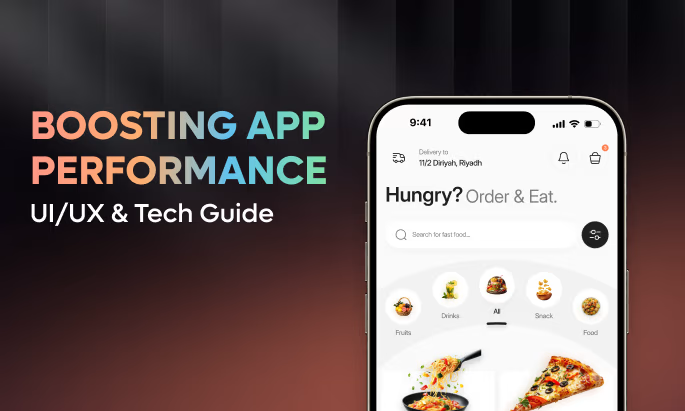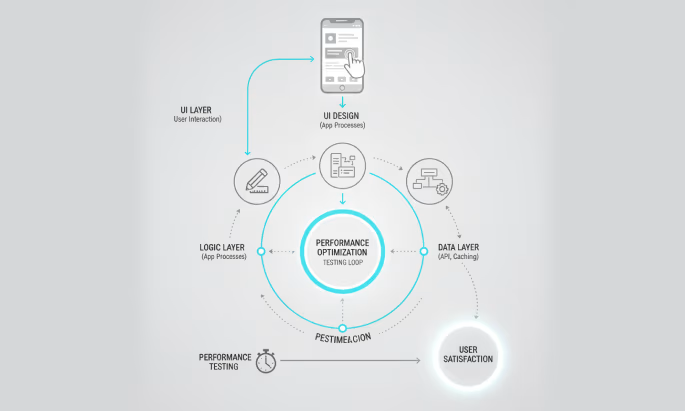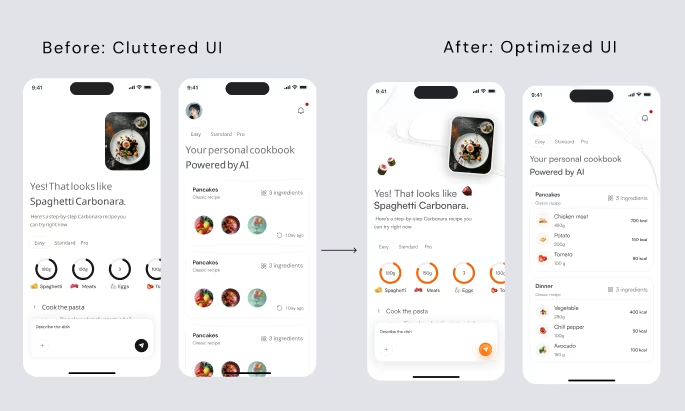
When an app runs smoothly, users rarely notice. But when it doesn’t—when loading drags, screens stutter, or actions feel delayed—they leave. App performance isn’t just a technical benchmark; it’s the foundation of user experience, trust, and long-term growth. In the competitive mobile landscape, every second counts, and every interaction influences how users perceive your brand. Whether you’re a startup founder preparing to launch your first product, a UI/UX designer focused on refining the user journey, or a tech team maintaining a large-scale application, understanding and improving app performance is essential to staying ahead.
App performance is the invisible thread connecting technology, design, and business outcomes. A responsive interface feels intuitive because it respects the user’s time. A well-architected app scales effortlessly because it’s built on thoughtful foundations. Performance is not an afterthought—it’s the outcome of hundreds of small, smart decisions throughout design and development.
Why performance has become non-negotiable
Between 2023 and 2025, expectations for mobile performance have accelerated dramatically. Users have grown accustomed to seamless experiences powered by apps like TikTok, Spotify, and Uber, where load times are almost imperceptible and design transitions flow effortlessly. This shift has raised the baseline for everyone else. Startups can no longer rely on design novelty alone; performance is now a core part of product value.
At the same time, the tools available to improve performance have expanded. Frameworks like Flutter, React Native, and SwiftUI simplify optimization, while advanced analytics platforms track micro-metrics such as frame-rate drops and network latency in real time. On the design side, faster prototyping and UI testing inside platforms like Figma or Framer allow teams to validate performance concepts before a single line of production code is written.
In practical terms, improving app performance means optimizing for speed, reliability, and consistency. The goal isn’t just faster rendering—it’s a holistic approach where visual design, code architecture, and infrastructure all contribute to a seamless experience.
The foundation: designing for performance
Good performance begins with good design. Every extra click, every animation, every large image or nested layout structure affects how an app feels and performs. UI/UX design isn’t only about aesthetics; it directly shapes technical efficiency.
When designers plan a user flow, they define what loads first, what can wait, and what data or visuals are critical at each step. Prioritizing this hierarchy of content reduces cognitive friction for users and computational load for devices. A simple onboarding flow that loads in under three seconds often retains twice as many users as one that takes longer, even if both deliver the same content.
In one redesign for a fintech client, the design team realized their original dashboard used multiple gradient layers, oversized vector charts, and embedded illustrations that added more than three megabytes to the initial load. By restructuring the design, switching to lightweight SVG assets, and deferring non-critical components, the app’s launch time dropped from 4.2 seconds to 2.1 seconds. User session duration increased by 15 percent in the following weeks.
Designing for performance means making decisions that balance form and function. It’s choosing when to simplify, when to delight, and when to hold back.
Building the right architecture

Behind every responsive interface is a solid architectural foundation. A well-designed architecture reduces redundant processes, limits memory leaks, and enables the app to scale efficiently. This is especially vital for startups that anticipate rapid user growth or frequent feature updates.
The first architectural step is modularization. Instead of building one massive codebase, divide features into independent modules. This approach not only speeds up development but allows teams to load features dynamically, improving perceived performance. For example, an e-commerce app can load its product catalog immediately while deferring order history or profile management until the user needs them.
Another key element is caching. Efficient caching strategies—storing data locally on the device or using content delivery networks—reduce network calls and latency. When paired with well-structured APIs, this ensures users experience instant responses, even under weak connections.
In an internal performance audit for a health-tech app, the development team discovered that API responses averaged 1.8 seconds due to multiple redundant network requests. Implementing local caching and batch processing cut this to 400 milliseconds, reducing perceived lag dramatically.
Architecture isn’t glamorous, but it defines how far your design vision can stretch without breaking performance.
Testing what truly matters
Performance testing is where assumptions meet reality. Many teams test for functionality but neglect how the app behaves under real-world conditions—slow networks, older devices, or simultaneous data requests. A beautifully coded app can still feel sluggish if it hasn’t been stress-tested properly.
The best testing strategies combine automated performance benchmarks with human observation. Tools like Firebase Performance Monitoring, Xcode Instruments, or Android Profiler can reveal CPU usage, memory consumption, or rendering bottlenecks, but human testers notice subtle cues—how long a loading indicator feels, whether scrolling feels natural, or if transitions distract rather than guide.
In one case study, a travel booking startup found their app technically met performance standards on paper but still received complaints about “lag.” Deeper testing revealed that their animated background and parallax transitions caused micro-stutters on mid-range devices. By removing the background animation and optimizing scroll inertia, they reduced frame drops by 40 percent, eliminating user frustration.
Testing isn’t a final step; it’s a continuous loop that begins early and never ends.
Redesigning with performance in focus

An app redesign presents the best opportunity to integrate performance improvements. Too often, redesigns prioritize visuals or branding updates while underlying inefficiencies remain untouched. A performance-driven redesign approaches every visual decision with an engineering mindset.
When a SaaS startup approached their design agency for a visual refresh, the team first conducted a performance audit. They found outdated third-party SDKs, unoptimized image libraries, and a monolithic backend that delayed data retrieval. Instead of simply updating the interface, they rebuilt the layout with asynchronous data loading, reduced font variations, and introduced lightweight UI states for faster feedback. The redesigned app loaded 45 percent faster and scored higher on both Google Play and App Store metrics.
Redesigning for performance isn’t about removing character it’s about aligning every design detail with responsiveness and efficiency.
The role of UI/UX in growth
Performance is inseparable from user experience, and user experience drives growth. Every millisecond saved contributes to user satisfaction, retention, and brand loyalty. For a startup, this can mean the difference between steady growth and silent churn.
Apps like Revolut, Calm, and Duolingo didn’t grow solely through marketing—they grew through consistency and speed. Users trust experiences that feel reliable. A fintech user checking balances expects instant results; a health app user expects real-time updates. These expectations form part of what’s known as design performance—the fusion of visual clarity, usability, and speed.
A consistent 60-fps animation may seem like a technical detail, but it’s a psychological signal that the product is competent and trustworthy. When users sense lag, they subconsciously lose confidence. This is where designers wield enormous influence over perceived performance. By simplifying transitions, using progressive loading, and eliminating visual clutter, designers help users feel faster—even if underlying operations remain constant.
Technology optimizations behind the scenes

While design handles the visible aspects of performance, technology carries the hidden load. Image compression, code minification, network request optimization, and asset management all add up. Simple changes—like converting images to next-gen formats (WebP or AVIF) or using vector icons can cut load times in half.
Threading also plays a vital role. Heavy computations or data parsing should run on background threads, freeing the main UI thread to remain responsive. When the UI thread freezes, users perceive lag even if the app hasn’t technically crashed.
Developers must also manage memory wisely. Memory leaks or oversized data structures can degrade performance over time, leading to random slowdowns or crashes. Regular profiling with built-in tools helps maintain consistency as features scale.
A practical example: during the development of a delivery app, engineers discovered that loading high-resolution map tiles consumed excessive memory. By implementing on-demand tile fetching and caching smaller regions, they reduced memory usage by 35 percent and stabilized performance on lower-end devices.
Technology optimization may not be glamorous, but it’s where the best apps earn their reliability.
The human side of app speed
It’s easy to think of performance as numbers—load times, frames per second, or memory footprint. But what really matters is perception. The difference between an app that feels instant and one that feels sluggish often comes down to micro-interactions and timing cues.
For instance, a button that gives immediate visual feedback—even before a server confirms the action—feels faster. A skeleton screen that previews layout structure while content loads reassures users that progress is happening. Perceived performance is a design discipline in itself.
This concept was key when a media streaming app redesigned its home feed. Users complained that videos “took too long to start,” even though buffering times were only 1.2 seconds. By adding a preview thumbnail animation that played instantly while the stream initialized, the perceived wait dropped to almost zero. Engagement rose by 10 percent in the following month..
Measuring what matters
To sustain performance, teams need reliable measurement frameworks. Analytics tools should capture real-time data such as startup duration, render delay, frame rate, and crash frequency. However, quantitative data must be complemented with user feedback and usability testing. Numbers tell you “what” is happening; users tell you “why.”
Linking performance to business metrics creates a feedback loop. Faster load times often correlate with higher retention, lower churn, and increased session duration. Tracking these relationships transforms performance from an engineering KPI into a strategic growth metric.
For a startup founder or product manager, setting clear performance goals—like maintaining a sub-two-second launch on average hardware—helps align design and engineering priorities. When everyone shares responsibility for speed, performance becomes a team value rather than an isolated task.
Continuous optimization through collaboration
Improving performance is never a solo mission. Designers, developers, QA engineers, and product leads must collaborate closely. The most successful teams treat performance like accessibility or security—a shared commitment built into every decision.
In collaborative environments, designers present prototypes with clear performance expectations, developers communicate architectural constraints early, and QA teams conduct tests under realistic conditions. Cross-disciplinary communication prevents surprises late in production, where performance fixes are costlier and riskier.
At one agency, regular “performance reviews” were introduced alongside design critiques. Instead of only discussing layout or typography, designers and developers jointly reviewed frame times and launch speeds. This practice not only improved technical quality but also fostered a shared culture of responsibility.
Balancing trade-offs
Every app project involves trade-offs. Adding a rich animation may enhance delight but cost milliseconds. Including multiple libraries may accelerate development but inflate build size. Leaders must balance these factors strategically.
The key is intentional decision-making. Not every feature must be the fastest; it must be fast enough for its purpose. For a finance dashboard, speed is critical because users expect instant updates. For a storytelling app, slightly slower transitions might be acceptable if they enhance emotional resonance. Understanding context prevents over-optimization that harms creativity.
Startups often struggle here: rushing features to market while trying to maintain speed. The best practice is to define a performance budget—specific limits for load size, memory use, and response time—and evaluate every new addition against it.
Performance during scaling and maintenance
Once an app gains traction, maintaining performance becomes more challenging. Each new feature, library, or SDK can subtly degrade speed. Without monitoring, these small changes accumulate into major issues.
Implementing automated performance regression tests ensures every update meets the same standards as the original build. Periodic audits of code dependencies, asset libraries, and analytics SDKs prevent unnecessary bloat. Additionally, keeping analytics on real-world performance helps detect degradation early—before users notice.
When a healthcare app scaled from 50,000 to 500,000 users, developers saw gradual increases in network latency. Their monitoring tools traced the issue to database query overload. Optimizing the API and caching strategy restored original speed levels and prevented a mass drop in satisfaction ratings.
Sustaining performance is a continuous process, not a one-time project milestone.
Ethical responsibility and accessibility
There’s also an ethical layer to performance. Poorly optimized apps consume more battery, bandwidth, and data, disproportionately affecting users on lower-end devices or limited internet plans. Inclusive design means considering these users too.
Lightweight interfaces, offline support, and careful asset management make technology accessible to more people. In many regions, this isn’t just a courtesy—it’s a necessity for growth. Responsible performance design respects both users and the planet by minimizing energy and data waste.
Performance as a brand differentiator
In crowded markets, speed and responsiveness are becoming brand assets. Users equate efficiency with professionalism. Companies that invest in app performance don’t just gain technical advantages—they strengthen trust and reputation.
When Apple advertises smooth transitions or Google emphasizes instant search results, they’re marketing performance as a value. Startups can do the same. A fast, stable app is a silent ambassador for reliability.
A study by Google found that 53 percent of users abandon mobile sites that take more than three seconds to load. The same principle applies to apps. Faster performance equals better retention and more organic advocacy.
Getting started with performance optimization
For designers or founders new to the subject, the first step is awareness. Audit your current app honestly. Measure startup time, test on older devices, note when users hesitate or complain. Collect quantitative and qualitative data. Then prioritize issues by impact.
Start small: compress images, remove unused assets, streamline navigation, and simplify transitions. From there, refine caching, network requests, and architectural efficiency.
In many cases, improving app performance is less about adopting new tools and more about removing unnecessary complexity. Each kilobyte, animation, or dependency you eliminate contributes to smoother operation.
If your team is new to performance testing, platforms like Firebase Performance Monitoring or UXCam offer intuitive dashboards that visualize app responsiveness and user flow in real time.
Linking performance to long-term growth
Performance improvements directly influence growth metrics such as session length, user retention, and customer lifetime value. Users who experience reliability are more likely to return, recommend, and upgrade.
Investors also view performance as a maturity signal. A well-optimized app demonstrates technical competence and scalability—key factors for funding and partnership opportunities.
Startups in fintech, health, and productivity sectors see the highest returns from performance work because trust and reliability drive conversions. Faster load times lead to more transactions, better reviews, and higher ranking in app stores.
A final reflection
App performance is where design integrity meets technical excellence. It’s the sum of thoughtful decisions—how screens load, how data flows, how interactions feel. It’s invisible when done right and painfully obvious when ignored.
For founders, performance is a growth strategy. For designers, it’s an extension of user empathy. For developers, it’s a reflection of craftsmanship. Together, these perspectives form a complete view of how to build technology that feels effortless.
Improving app performance doesn’t mean stripping personality from design or sacrificing creativity. It means shaping experiences that respect users’ time and attention. In an age where every tap counts, speed has become the ultimate form of elegance.
Frequently Asked Questions (FAQ)
Q1: What is app performance and why does it matter?
App performance refers to how quickly and smoothly your mobile application responds to user actions, loads screens, processes data, and remains stable on a variety of devices and network conditions. It matters because slow, laggy, or crashing apps lead to poor user experience, higher uninstall rates, lower retention, and reduced mobile app growth. Performance problems can directly hurt business metrics like conversion, engagement, and ratings.
Q2: How can UI/UX design impact app performance?
UI/UX design impacts app performance because the visual layout, transition complexity, asset size, and flow structure all affect how much work the app has to do under the hood. For example, heavy animations, large background images, or multiple nested screens increase rendering work and load time. By designing with simplicity, prioritising critical content, deferring non-essential visuals, and ensuring usability on lower-end devices, you directly improve perceived and actual performance.
Q3: What are the most important technological optimisations for better app performance?
Key technical optimisations include modular architecture, efficient data-caching strategies, background threading (so the UI thread doesn’t block), network payload reduction, image and asset compression, memory leak prevention, and testing on low-end devices and poor network conditions. These under-the-hood improvements help the UI feel responsive and keep performance consistent over time.
Q4: How often should we perform performance testing, and what should it cover?
Performance testing should be part of every major release cycle, and ideally integrated into your continuous integration/continuous deployment (CI/CD) pipeline. It should cover launch times (cold and warm starts), frame-rate or UI thread responsiveness, memory/CPU usage, network latency, crash/error rates, and also real-user behaviour under different device and network conditions. Consistent monitoring ensures you catch performance regressions before they impact users.
Q5: If we’re redesigning our app, how can we ensure performance improves rather than degrades?
When redesigning, start with a performance audit: measure current launch times, asset sizes, memory usage, user drop-off metrics. As you redesign, build with performance in mind: simplify visuals, reduce dependencies, optimise assets, refactor architecture if needed, lazy-load noncritical modules, test on realistic conditions. At every step, measure the change so you can confirm improvement rather than just change.
Fresh UI/UX Ideas, Straight to Your Inbox





